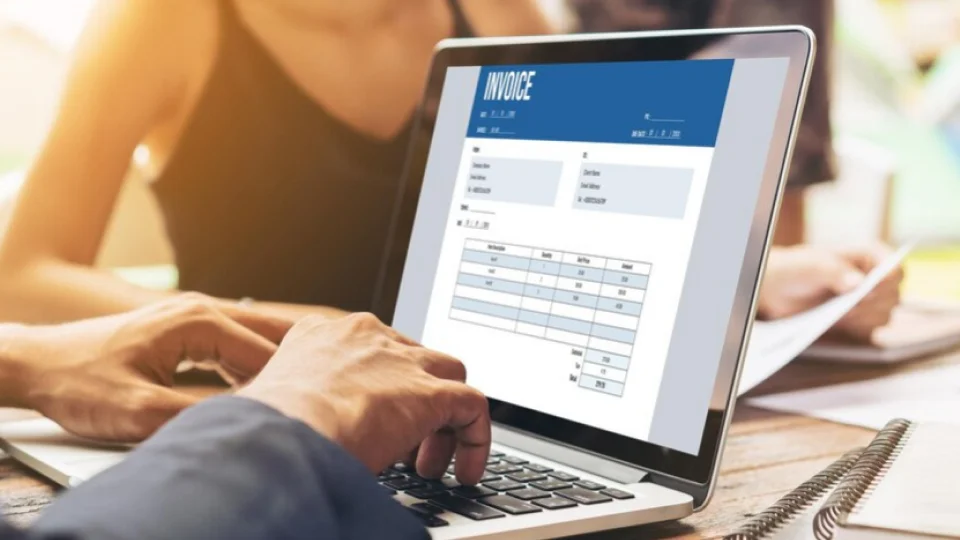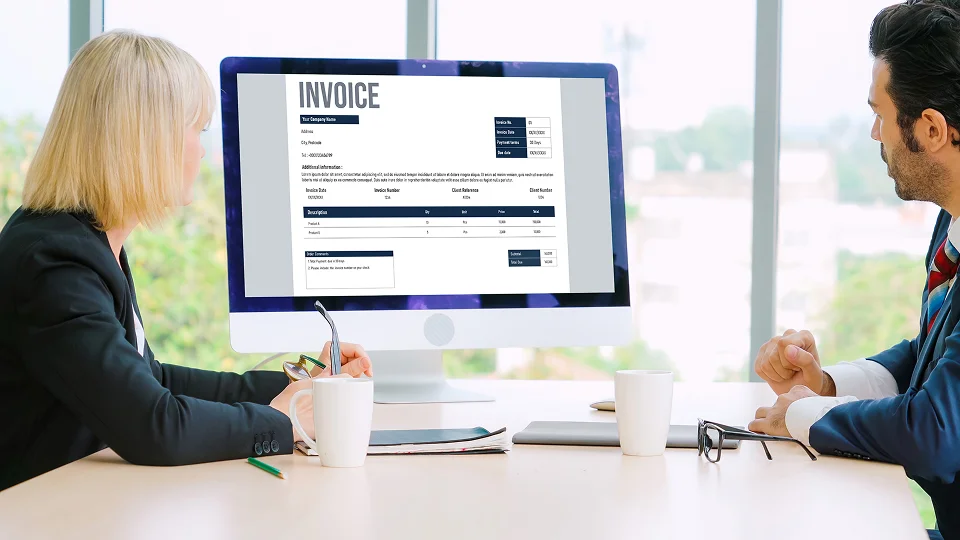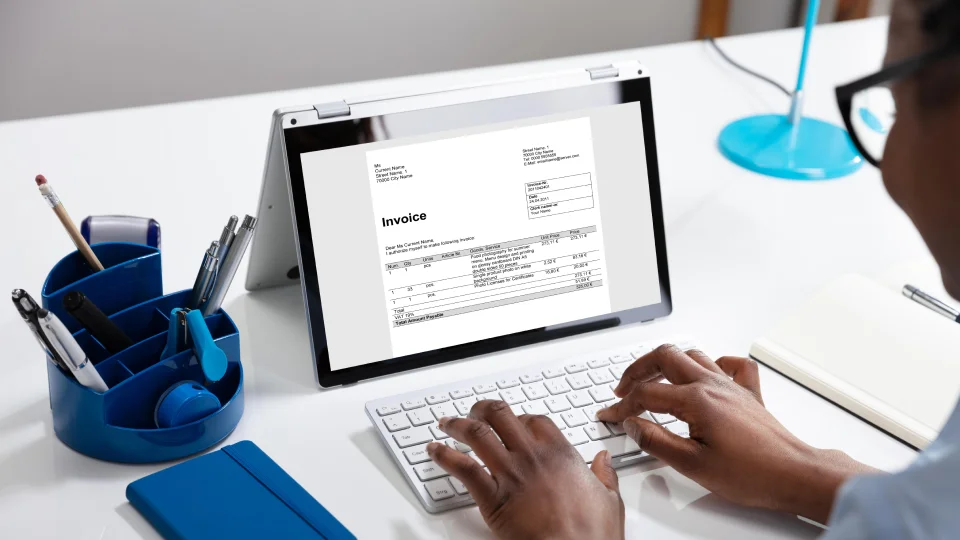

![How To Write an Invoice Email [+ Free Template]](https://psn-production-storage.s3.us-east-1.amazonaws.com/cdn/blog/2025/08/804/conversions/invoice-email-preview.webp)
Getting paid shouldn’t be a hassle, but if your invoice emails are unclear or too informal, they can slow down the process. Whether you’re a freelancer or a small business owner, writing a professional invoice email helps you get paid faster, reduces back-and-forth, and builds trust with clients.
This blog will guide you through the essentials of writing a professional invoice email, from crafting an attention-grabbing subject line to including all necessary details in the message body. We'll dive into why these emails matter, emphasize first impressions, and walk you through best practices to make your emails polished and concise.
Last, you’ll learn about common pitfalls to avoid and how tools like Paystubsnow can simplify the process. We’ve also included a handy template for you to use.

Invoicing isn't just about requesting payment. It’s about creating a smooth, professional experience for your client. A well-written invoice email helps avoid confusion, speeds up payment, and reflects positively on your business.
Your invoice email is often the final touchpoint in a transaction, and first impressions matter. A well-crafted, polite, clear email conveys professionalism and reinforces your credibility. Clients are more likely to respond positively when they get an invoice to receive payment that’s respectful in tone.
A professional invoice email helps with immediate payment by clearly stating the amount due, the deadline, and payment instructions. When everything is easy to understand, there are fewer delays. Recipients quickly identify and settle their dues promptly when they don’t have to ask for clarification.
Your invoice email is an extension of your brand . Consistency in tone, design, and messaging across all client communication builds brand recognition and trust. Including your logo, using your brand colors, and maintaining a professional tone can leave a lasting impression.
 With the importance of invoices covered, let’s explore the essential components that make an invoice email effective and professional.
With the importance of invoices covered, let’s explore the essential components that make an invoice email effective and professional.
Craft a clear subject line that immediately communicates the purpose of the email. Including the word “Invoice” along with the invoice number or client name adds clarity and helps the recipient prioritize it. For example, “Invoice #1245 from ABC Services.”
Start the email with a polite and personalized greeting. Using the client’s first name or company name adds a professional touch while showing attention to detail. For instance, “Dear John” or “Hello XYZ Team” works well. A more general “Dear Client” is acceptable if the contact person is unknown.
The opening line should briefly state the purpose of the email body in a friendly and professional manner. A simple sentence like “I hope you’re well” followed by “Please find attached your invoice for \ [service]” works effectively. This creates a positive tone while immediately setting expectations.
Mention the invoice number , date, billing period, and a brief description of the services or products. All the necessary details should match the invoice attached to prevent any confusion. Include the total amount due and highlight any taxes or discounts applied. You can use accounting software for this step.
Outline the invoice payment methods accepted and any specific details needed to complete the transaction, such as bank account details, payment links, or online portals. Specify the due date and mention any late fees or early payment discounts if applicable.
End the email with a polite thank you and a short note encouraging the client to reach out if they have any questions. For example, “Thank you for your business. Please let us know if you need any clarification.” Sign off with your name, job title, and contact details.
Next, let’s explore the essential practices that can transform your invoicing process into a smooth transaction.
Maintain a courteous and respectful tone throughout your invoice email message. Use formal greetings and sign-offs, and avoid overly casual language. A professional approach helps build trust and reinforces your credibility.
Avoid lengthy explanations. State the purpose of the email upfront, mention the amount due, the due date, and any relevant detailed breakdown, and keep the content straightforward to prevent confusion or misinterpretation. A brief message that is informative will likely be read and acted upon quickly.
Before hitting send, proofread your invoice email carefully. Spelling mistakes, incorrect dates, or wrong amounts can undermine your professionalism and cause payment delays. Review both the email and the attached invoice to ensure accuracy.
Tailoring the email to the recipient adds a human touch. Use their name and reference specific services or projects if applicable. A personalized message shows you value the client and helps differentiate your message from generic emails.
Always attach the invoice as a PDF or another universally accessible format. Label the file clearly—something like “Invoice_#12345_CompanyName.pdf” works well. Mention the attachment in your email to avoid confusion.
 With all the dos in place, let's look into the common mistakes to avoid to ensure your communication stays crisp and professional.
With all the dos in place, let's look into the common mistakes to avoid to ensure your communication stays crisp and professional.
A vague or generic subject line can lead to your invoice email being ignored. Always include specific information such as the invoice number and client name. For example, “Invoice #45678 – Acme Corp.” ensures your recipient knows exactly what the email is about with a descriptive subject line.
Missing essential details like the due date can cause payment delays. Clients need all necessary information to process your invoice efficiently. Always double-check that the invoice includes your business name, client name, contact details, and tax (an invoicing software can help calculate taxes).
While a friendly tone is fine, the message should reflect a business relationship. Avoid slang or overly relaxed phrasing; stick to clear, respectful communication. For example, instead of saying “Hey, just sending over what you owe,” opt for “Please find attached your invoice for services rendered.”
Always state the due date, accepted payment methods, and any late fees upfront. This ensures both parties are on the same page and avoids confusion later on. If you expect payment within 14 days, say so clearly in the email or invoice. Being specific about expectations maintains professional boundaries.
Cluttered or disorganized emails can frustrate recipients and make important details hard to find. Use short paragraphs, bullet points, and proper spacing to improve readability. Attach the invoice as a named PDF, and keep the email text concise and easy to scan.
 If invoices aren't paid on time , following up is crucial to ensure timely payment. Here's how to approach follow-ups effectively, maintaining professionalism while asserting your payment needs.
If invoices aren't paid on time , following up is crucial to ensure timely payment. Here's how to approach follow-ups effectively, maintaining professionalism while asserting your payment needs.
You should send a follow-up email when the payment due date passes without a receipt. Start with a polite reminder within 1–3 days of the due date, then escalate with firmer language if no response is received. Consistency is key. Follow a schedule with multiple formal letter reminders over a few weeks.
Begin with a friendly email reminder, then follow up with phone calls if necessary. Offer to clarify any concerns that might delay payment. If no progress is made, apply the late fees outlined in your terms. In rare cases of persistent non-payment, sending a final notice for legal proceedings may be necessary.
Generating invoices shouldn't be a stressful task, and with Paystubsnow, it’s as easy as one, two, three. Let’s walk you through the steps to quickly create and send polished invoices.
Start by selecting a professional invoice template from Paystubsnow’s available options. Each template is designed to suit various industries and business types. You’ll find a format that reflects your brand. Once selected, you can begin customizing the content to match your needs.
Enter all necessary billing information, including your name, client details, itemized services, rates, and due dates. Paystubsnow’s intuitive platform makes this process quick and straightforward. You can add taxes, discounts, and payment instructions to ensure accuracy and clarity.
Before finalizing your invoice, take a moment to double-check all entered information. Make sure everything is accurate and professional. Once satisfied, you can download the invoice as a PDF or email it directly to your client using Paystubsnow’s secure delivery method and feature.
Looking for more invoicing automation or lower credit card processing fees?
Blinksale is a simple, full-featured invoicing tool that lets you save clients, automate recurring invoices and reminders, and accept payments via credit card. It’s ideal for businesses that want fast, professional billing—with built-in, low cost payment processing with support for low to high-risk industries.
Need help writing the email and creating the invoice? Below is a simple, professional invoice email template you can copy and customize for any client. And if you haven’t created your invoice yet, our invoice generator makes it easy to build and download a polished PDF you can attach directly to your email.
Subject: Invoice for \ [Project Name or Service] – Due \ [Due Date]
Body:
Hi \ [Client Name],
I hope you're doing well! Please find attached the invoice for \ [brief description of work], completed on \ [date or project timeframe].
The total amount due is \ [amount], payable by \ [due date]. You can make payment via \ [payment method or link, if applicable]. If you have any questions, feel free to reach out.
Thanks again for the opportunity. I really appreciate your business.
Best regards,
\ [Your Name]
\ [Your Business Name]
\ [Contact Info]
Writing a clear, professional invoice email is a simple but powerful way to speed up payments, maintain strong client relationships, and avoid confusion. By following best practices—from subject line to sign-off—you can ensure your communication is polished and effective every time.
Paystubsnow helps you take that professionalism even further. Our platform makes it easy to generate invoices, pay stubs, W-2s, 1099-NEC forms, and utility bills—all from one place. Designed for freelancers, solopreneurs, and small businesses, Paystubsnow simplifies your bookkeeping so you can focus on growing your business.
Revolutionize your financial processes with Paystubsnow today!